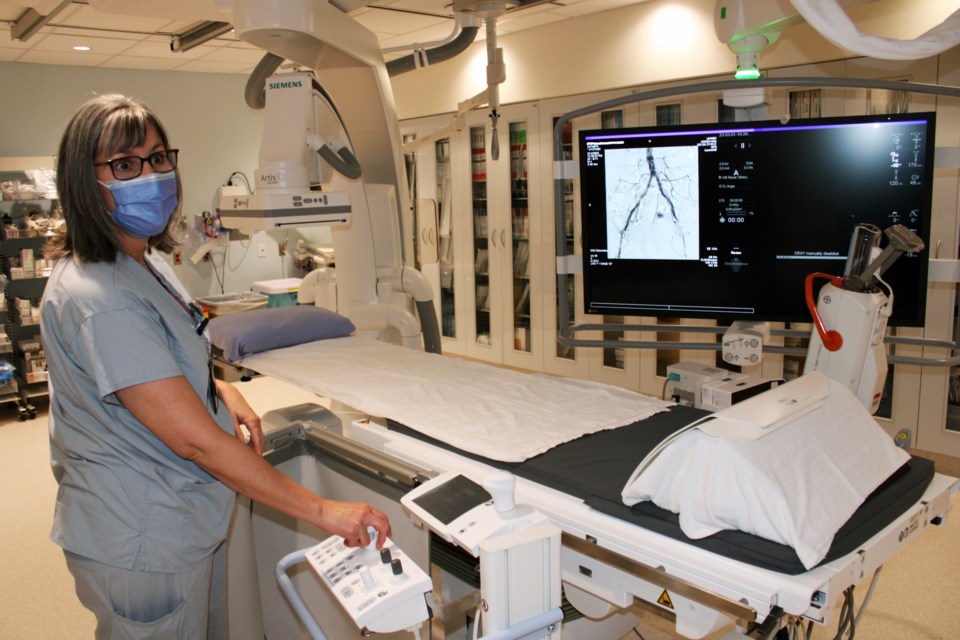New medical imaging equipment at UHNBC in Prince George allows doctors to peer beneath the skin and track real-time movements in the body to pinpoint obstructions and insert medical devices, resulting in less invasive procedures.
The upgrade in technology is helping women avoid hysterectomies and allowing interventions that give previously infertile women the ability to conceive children.
“Now that we have this unit, we’re introducing a new procedure for ladies and instead of having a total hysterectomy (to remove the uterus) we can do a very simple procedure in this room that would negate the necessity for a big surgery,” said Debbie Johnston, a clinical resources nurse for medical imaging.
Johnston was Canada’s second certified radiology nurse when she returned to Prince George to work at UHNBC 31 years ago and the diagnostic equipment and interventional procedures available then, such as an angiogram, were primitive by comparison.
“It’s so invigorating to be part of this expansion with the new equipment and the increased services we offer,” said Johnston.
Fluoroscopy utilizes x-ray imaging to provide real-time video of movements in the body to help doctors locate blockages. The moving images show such things as food being chewed and ingested to diagnose problems with digestion. Doctors use monitors to guide precise injections deep into the spine or joints. Using contrasting dyes, they can produce a roadmap of the patients anatomy and the screen image guides them as they insert needles, catheters, stents and other medical devices into vessels that supply blood to the legs, stomach and kidneys.
“There are many procedures we can do that do not require surgery,” said Dr. Roshni Patel, a UHNBC interventional radiologist. “Patients come in and have a procedure done through a little hole in their femoral artery and we can put in stents that may mitigate the need to have open surgery to fix blood vessels in the abdomen or legs. The patients go home four hours later and they’re up and walking the next day.”
Orthopedic surgeons use fluoroscopy to guide joint replacements or check on healing of broken bones. It’s used on kidney dialysis patients who require drains or tubes to be inserted and for cancer patents who need biopsies or chemotherapy. The state-of-the-art equipment gives doctors the ability to repair aneurisms in blood vessels and remove gall stones without surgery.
“We gain access with a needle and then we use the x-ray machine and our knowledge of anatomy to navigate our wires and catheters and tubes through the skin,” said Patel.
Opened in December, the interventional radiology/fluoroscopy suite at UHNBC allows doctors to precisely insert wire catheters to open blocked fallopian tubes in a procedure called recanalization. Prior to the new imaging equipment coming to Prince George a year ago, that required a trip to a Vancouver hospital.
Men with urinary conditions are also reaping the benefits of a new procedure called prostate artery embolization, to locate blockages and treat problems of incontinence or bladder leakage without surgery, using routine procedures to open up vessels and restore blood flow.
The upgraded fluoroscopy suite at UHNBC has been tripled in size to allow for storage and a four-bed patient preparation/recovery area, replacing a confined three-bed space that had no equipment storage capacity and very little room for doctors and nurses to work on a patient.
The equipment works from either side and the table on which the patient rests can by tilted to improve access and accommodate patients who are prone to fainting. Three nurses are assigned to each shift to work in the suite, where there was only one before the expansion.
“It has a lot of features on it we didn’t have with our old machine, so we can do a spin CT (scan) and it can go around 270 degrees so you get 3-D imaging with it, which can be very helpful when we have catheters the doctors are trying to see,” said intervention radiology technologist Tracy Van Somer. “It just has increased our workflow and efficiency so much by having everything here and more dedicated staff.”



.png;w=120;h=80;mode=crop)